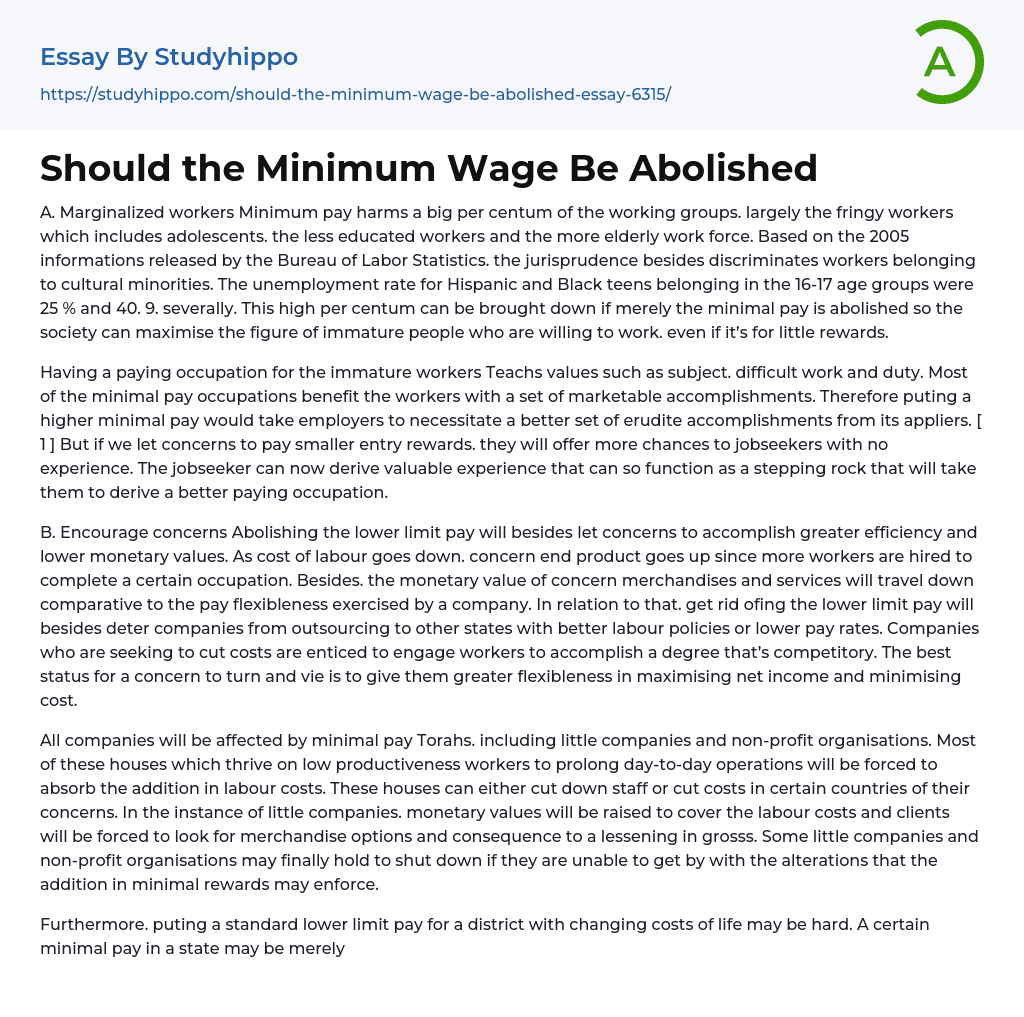The minimum wage has a negative impact on various groups of workers, particularly marginalized individuals such as adolescents, those with less education, and the elderly. Data from the Bureau of Labor Statistics in 2005 suggests that this law also discriminates against ethnic minority workers. For instance, unemployment rates for Hispanic and Black teenagers aged 16-17 were 25% and 40.9%, respectively. By eliminating the minimum wage requirement, these high percentages could decrease while offering more job opportunities to young people even if at lower wages. Such jobs are valuable as they teach important values like discipline, hard work, and responsibility while providing useful skills applicable in other job markets.
Consequently, setting a higher minimum wage would necessitate applicants to have more advanced skills. However, if businesses are permitted to offer lower entry-level wages, it could create additional ch
...ances for inexperienced job seekers who can gain valuable experience leading to higher-paying jobs later on. Besides benefiting workers directly, getting rid of the minimum wage would allow businesses to enhance efficiency and reduce prices. As labor costs decrease under this scenario, businesses can operate more effectively while cutting expenses.The cost of goods and services increases as more workers are hired, causing the value of products to decrease compared to flexible wages. Eliminating the minimum wage discourages companies from outsourcing to countries with better labor policies or lower wages. This is because when companies aim for cost reduction, they may be tempted to hire workers at competitive levels for maximum profit while minimizing costs. It's important to note that all companies, including small businesses and nonprofits, are impacted by minimum wage laws. For those reliant on low productivity workers, highe
labor costs resulting from a higher minimum wage would require reducing staff or cutting business expenses. In some cases, small companies may increase prices to cover these labor costs, potentially leading customers towards alternative products and decreasing revenue. Unfortunately, some small businesses and nonprofits may even close if they cannot handle the changes imposed by increased minimum wages. Another challenge arises when setting a standard minimum wage for a district with varying living costs since what may be appropriate in one state could be too high for others. For example, a $7 per hour minimum wage may be suitable for urban areas but excessive for rural areas.The minimum wage law can lead to higher labor costs, prompting companies to invest in automated machines as an alternative. Tasks like cash registers and online marketing can now be easily automated, reducing costs and improving efficiency. Companies strive to produce affordable yet high-quality products in order to attract consumers in today's competitive global economy. Cheaper and equally reliable products gain more attention from consumers who have the option to purchase them. By reducing labor costs, companies aim to maximize labor efficiency and meet market prices, ultimately leading to cheaper products. However, countries with high minimum wages face challenges in maintaining low product prices. Introducing a minimum wage often results in higher selling prices per product because of increased direct labor cost per hour, putting companies at a disadvantage compared to foreign states with lower or no minimum wage regulations. These foreign companies have an advantage in price control as they can hire employees at lower labor costs while also improving product quality by employing more workers. Additionally, employees
do not tolerate unfair compensation practices. Although the government has authority over companies through implementing minimum wage laws, they often overlook the broader impact.Enforcing a minimum wage has negative effects on company efficiency, competitiveness, and employment opportunities. Increasing the minimum wage annually exacerbates these issues by reducing production efficiency, lowering profits, and preventing the hiring of new workers, resulting in unemployment. As a result of these regulations, both unemployment rates and GDP decrease. The text emphasizes the relationship between unemployment, GDP, and minimum pay, stating that for every 1% increase in unemployment there is a corresponding 2% decrease in GDP. However, eliminating minimum pay can lead to a decline of 5-3% in GDP while also having positive overall impacts. The main argument presented is that implementing minimum pay laws negatively affects both unemployment rates and GDP within an economy. This viewpoint is supported by examples from countries like Singapore which have achieved success without mandating minimum pay. Despite not having such regulations, Singapore maintains consistently low unemployment rates around 2%. This information is illustrated in Table 1 of manpower statistics data from 2011 to 2012 where the country's workforce has steadily increased over time (Table 1: Manpower Statistics).
- American Dream essays
- Barriers To Entry essays
- Capitalism essays
- Central Bank essays
- Compensation essays
- Consumerism essays
- Economic Development essays
- Economic Growth essays
- Economic Inequality essays
- Economic System essays
- Economy essays
- Employment essays
- Export essays
- Finance essays
- Free Trade essays
- Gross Domestic Product essays
- Human Development essays
- Income Inequality essays
- Industry essays
- Inflation essays
- International Business essays
- International Trade essays
- Macroeconomics essays
- Materialism essays
- Max Weber essays
- Microeconomics essays
- Minimum Wage essays
- Monetary Policy essays
- Monopoly essays
- Pricing essays
- Profit essays
- Recession essays
- resources essays
- Taxation essays
- Trade essays
- Unemployment essays
- Warehouse essays
- World economy essays
- Career essays
- Career Path essays
- Homeless essays
- Labour Economics essays
- Occupational Safety And Health essays
- Pension essays
- Profession essays
- Salary essays
- Strike Action essays
- Wage essays
- Working Together essays
- Workplace essays




